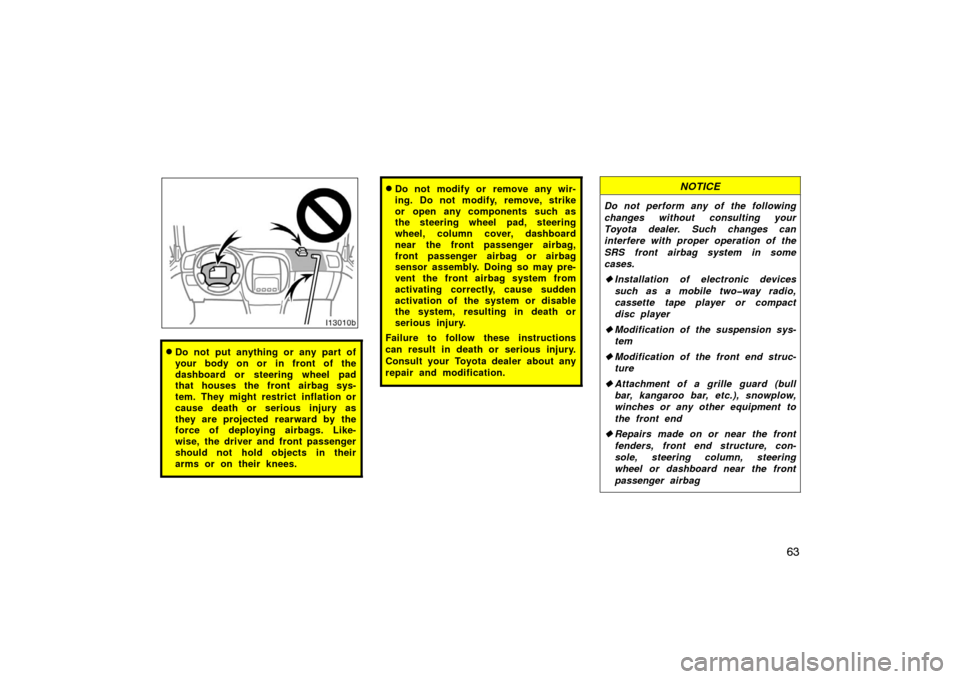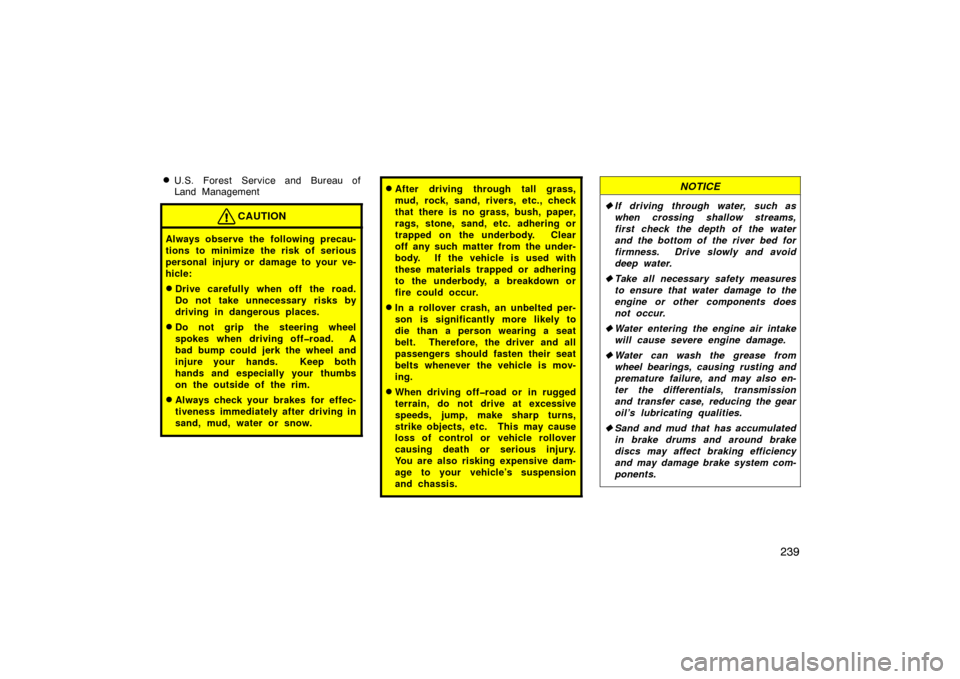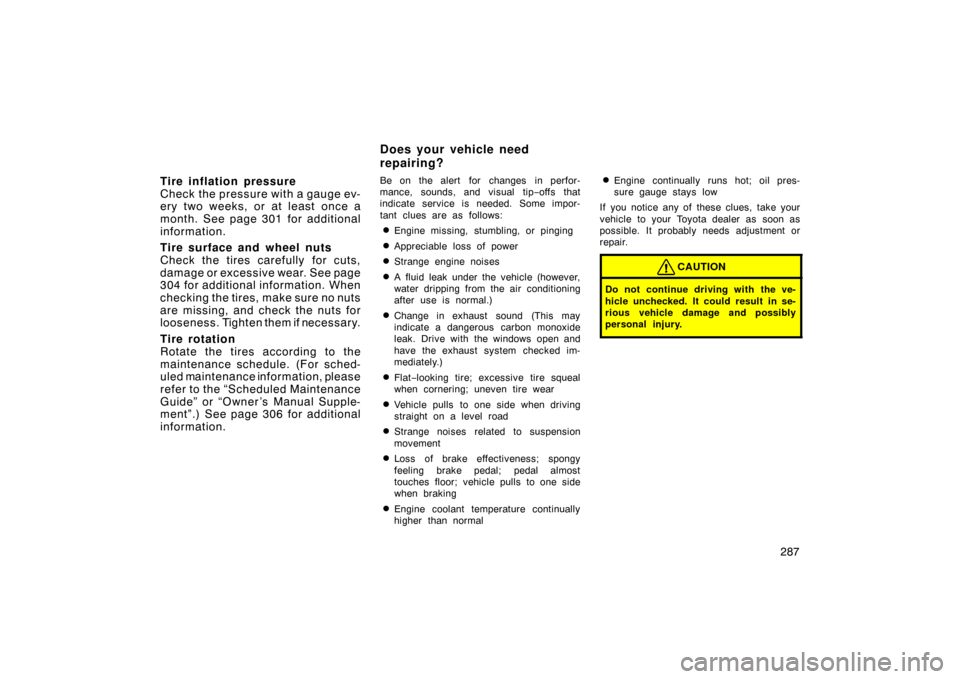Page 73 of 351

63
�Do not put anything or any part of
your body on or in front of the
dashboard or steering wheel pad
that houses the front airbag sys-
tem. They might restrict inflation or
cause death or serious injury as
they are projected rearward by the
force of deploying airbags. Like-
wise, the driver and front passenger
should not hold objects in their
arms or on their knees.
�Do not modify or remove any wir-
ing. Do not modify, remove, strike
or open any components such as
the steering wheel pad, steering
wheel, column cover, dashboard
near the front passenger airbag,
front passenger airbag or airbag
sensor assembly. Doing so may pre-
vent the front airbag system from
activating correctly, cause sudden
activation of the system or disable
the system, resulting in death or
serious injury.
Failure to follow these instructions
can result in death or serious injury.
Consult your Toyota dealer about any
repair and modification.NOTICE
Do not perform any of the following
changes without consulting your
Toyota dealer. Such changes can
interfere with proper operation of the
SRS front airbag system in some
cases.
� Installation of electronic devices
such as a mobile two�way radio,
cassette tape player or compact
disc player
� Modification of the suspension sys-
tem
� Modification of the front end struc-
ture
� Attachment of a grille guard (bull
bar, kangaroo bar, etc.), snowplow,
winches or any other equipment to
the front end
� Repairs made on or near the front
fenders, front end structure, con-
sole, steering column, steering
wheel or dashboard near the front
passenger airbag
Page 249 of 351

239
�
U.S. Forest Service and Bureau of
Land Management
CAUTION
Always observe the following precau-
tions to minimize the risk of serious
personal injury or damage to your ve-
hicle:
�Drive carefully when off the road.
Do not take unnecessary risks by
driving in dangerous places.
�Do not grip the steering wheel
spokes when driving off�road. A
bad bump could jerk the wheel and
injure your hands. Keep both
hands and especially your thumbs
on the outside of the rim.
�Always check your brakes for effec-
tiveness immediately after driving in
sand, mud, water or snow.
�After driving through tall grass,
mud, rock, sand, rivers, etc., check
that there is no grass, bush, paper,
rags, stone, sand, etc. adhering or
trapped on the underbody. Clear
off any such matter from the under-
body. If the vehicle is used with
these materials trapped or adhering
to the underbody, a breakdown or
fire could occur.
�In a rollover crash, an unbelted per-
son is significantly more likely to
die than a person wearing a seat
belt. Therefore, the driver and all
passengers should fasten their seat
belts whenever the vehicle is mov-
ing.
�When driving off�road or in rugged
terrain, do not drive at excessive
speeds, jump, make sharp turns,
strike objects, etc. This may cause
loss of control or vehicle rollover
causing death or serious injury.
You are also risking expensive dam-
age to your vehicle’s suspension
and chassis.
NOTICE
�
If driving through water, such as
when crossing shallow streams,
first check the depth of the water
and the bottom of the river bed for
firmness. Drive slowly and avoid
deep water.
� Take all necessary safety measures
to ensure that water damage to the
engine or other components does
not occur.
� Water entering the engine air intake
will cause severe engine damage.
� Water can wash the grease from
wheel bearings, causing rusting and
premature failure, and may also en-
ter the differentials, transmission
and transfer case, reducing the gear
oil’s lubricating qualities.
� Sand and mud that has accumulated
in brake drums and around brake
discs may affect braking efficiency
and may damage brake system com-
ponents.
Page 297 of 351

287
Tire inflation pressure
Check the pressure with a gauge ev-
ery two weeks, or at least once a
month. See page 301 for additional
information.
Tire surface and wheel nuts
Check the tires carefully for cuts,
damage or excessive wear. See page
304 for additional information. When
checking the tires, make sure no nuts
are missing, and check the nuts for
looseness. Tighten them if necessary.
Tire rotation
Rotate the tires
according to the
maintenance schedule. (For sched-
uled maintenance information, please
refer to the “Scheduled Maintenance
Guide” or “Owner ’s Manual Supple-
ment”.) See page 306 for additional
information.
Be on the alert for changes in perfor-
mance, sounds, and visual tip −offs that
indicate service is needed. Some impor-
tant clues are as follows:
�Engine missing, stumbling, or pinging
�Appreciable loss of power
�Strange engine noises
�A fluid leak under the vehicle (however,
water dripping from the air conditioning
after use is normal.)
�Change in exhaust sound (This may
indicate a dangerous carbon monoxide
leak. Drive with the windows open and
have the exhaust system checked im-
mediately.)
�Flat −looking tire; excessive tire squeal
when cornering; uneven tire wear
�Vehicle pulls to one side when driving
straight on a level road
�Strange noises related to suspension
movement
�Loss of brake effectiveness; spongy
feeling brake pedal; pedal almost
touches floor; vehicle pulls to one side
when braking
�Engine coolant temperature continually
higher than normal
�Engine continually runs hot; oil pres-
sure gauge stays low
If you notice any of these clues, take your
vehicle to your Toyota dealer as soon as
possible. It probably needs adjustment or
repair.
CAUTION
Do not continue driving with the ve-
hicle unchecked. It could result in se-
rious vehicle damage and possibly
personal injury.
Does your vehicle need
repairing?